International Business Management: The European Central Bank Analysis
VerifiedAdded on 2022/09/27
|14
|4278
|20
Essay
AI Summary
This essay delves into the crucial role of central banks, particularly the European Central Bank (ECB), in the global economy. The analysis begins by establishing the significance of central banks in fostering economic growth within their respective regions, with the ECB serving as a representative example. The essay examines the ECB's functions, including monetary policy, inflation control, and currency management, highlighting its impact on the Eurozone. It explores whether the ECB wields excessive political influence and power and investigates the mechanisms through which the ECB operates. Furthermore, the essay assesses the ECB's ability to mitigate future economic disruptions and crises, drawing on past events to evaluate its effectiveness. The discussion covers the importance of the ECB in maintaining financial stability, managing currency reserves, and acting as a lender of last resort. The essay also considers the political power of central banks, referencing expert opinions on their influence. The conclusion summarizes the ECB's multifaceted role in the European economy and its significance in maintaining economic stability and growth.
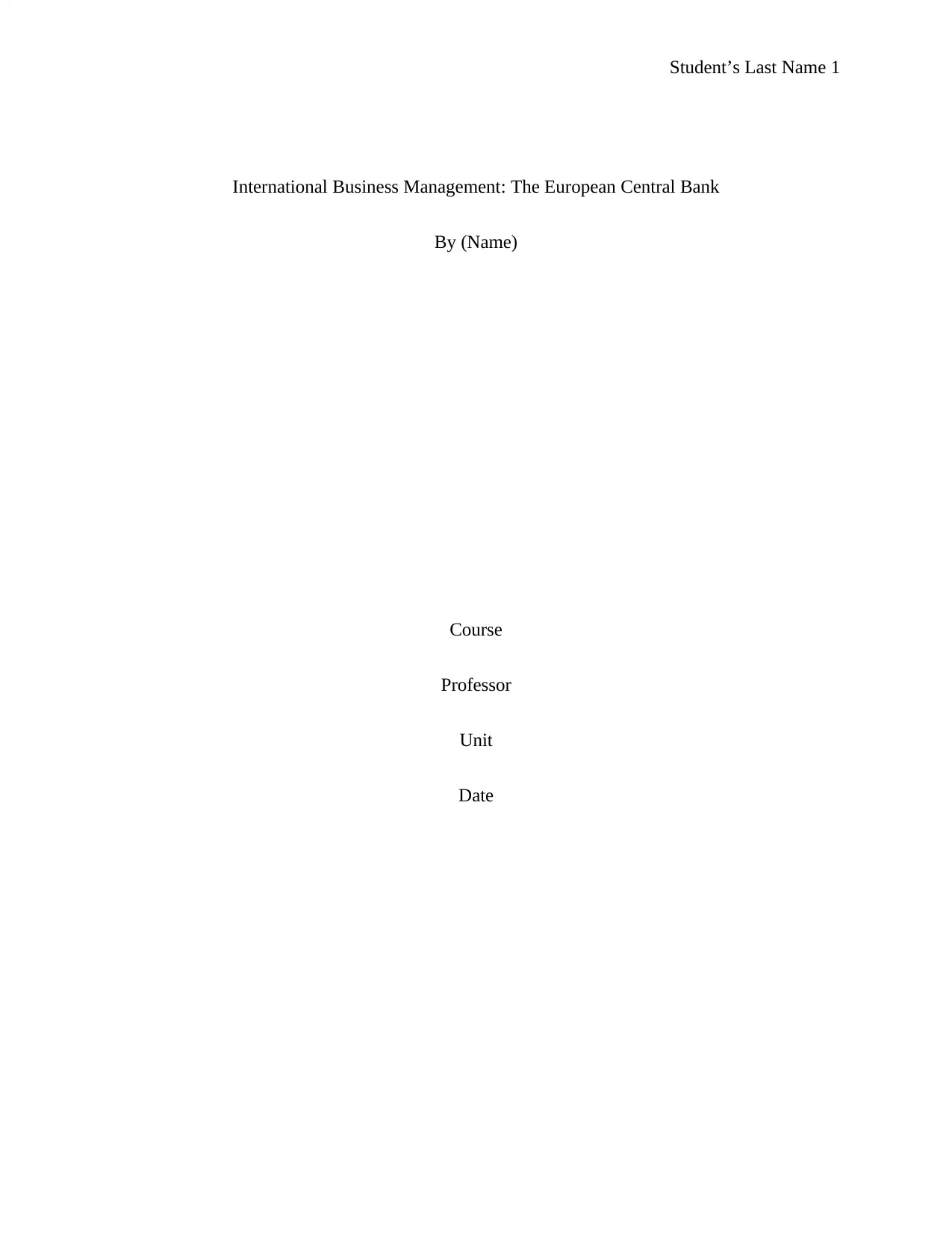
Student’s Last Name 1
International Business Management: The European Central Bank
By (Name)
Course
Professor
Unit
Date
International Business Management: The European Central Bank
By (Name)
Course
Professor
Unit
Date
Paraphrase This Document
Need a fresh take? Get an instant paraphrase of this document with our AI Paraphraser
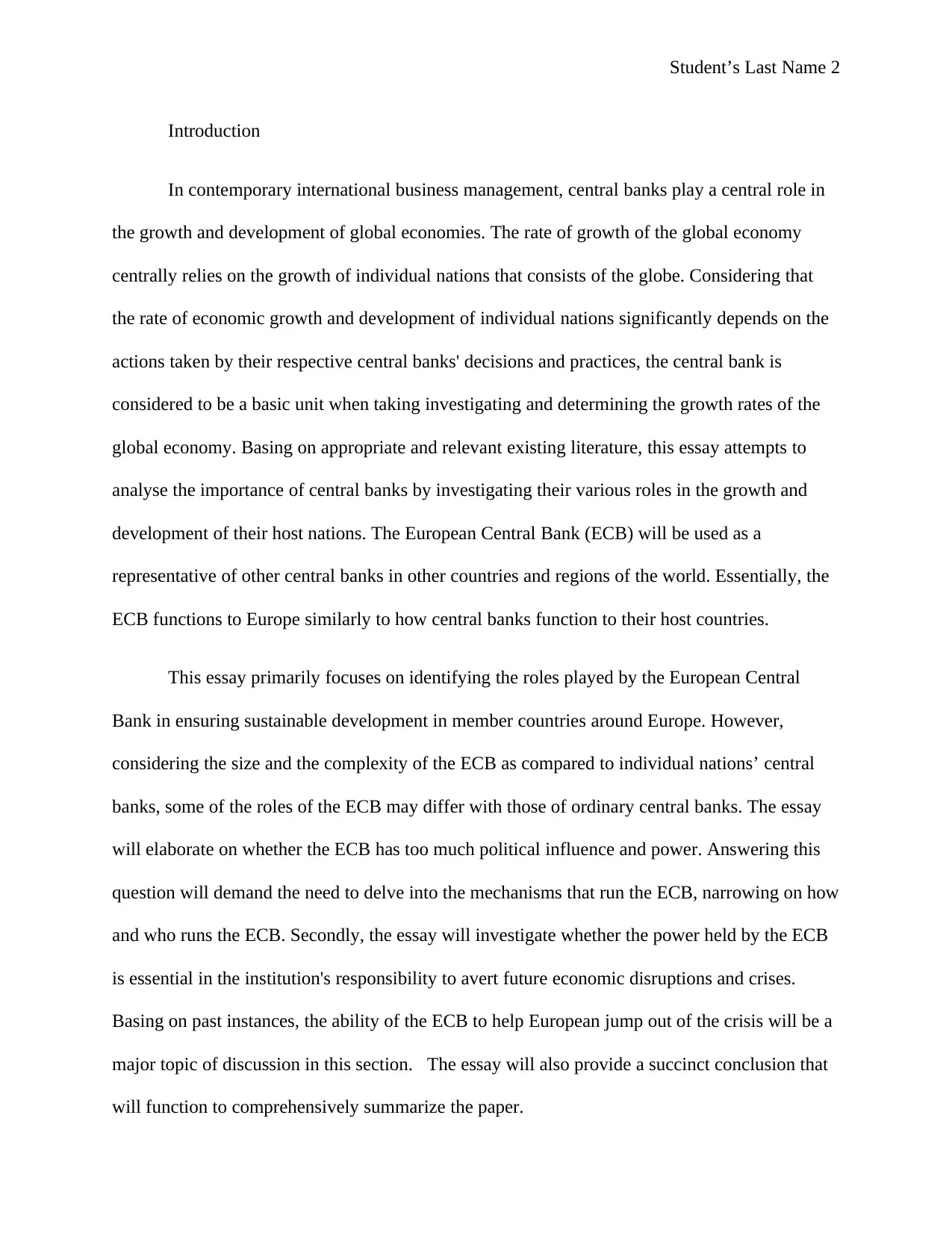
Student’s Last Name 2
Introduction
In contemporary international business management, central banks play a central role in
the growth and development of global economies. The rate of growth of the global economy
centrally relies on the growth of individual nations that consists of the globe. Considering that
the rate of economic growth and development of individual nations significantly depends on the
actions taken by their respective central banks' decisions and practices, the central bank is
considered to be a basic unit when taking investigating and determining the growth rates of the
global economy. Basing on appropriate and relevant existing literature, this essay attempts to
analyse the importance of central banks by investigating their various roles in the growth and
development of their host nations. The European Central Bank (ECB) will be used as a
representative of other central banks in other countries and regions of the world. Essentially, the
ECB functions to Europe similarly to how central banks function to their host countries.
This essay primarily focuses on identifying the roles played by the European Central
Bank in ensuring sustainable development in member countries around Europe. However,
considering the size and the complexity of the ECB as compared to individual nations’ central
banks, some of the roles of the ECB may differ with those of ordinary central banks. The essay
will elaborate on whether the ECB has too much political influence and power. Answering this
question will demand the need to delve into the mechanisms that run the ECB, narrowing on how
and who runs the ECB. Secondly, the essay will investigate whether the power held by the ECB
is essential in the institution's responsibility to avert future economic disruptions and crises.
Basing on past instances, the ability of the ECB to help European jump out of the crisis will be a
major topic of discussion in this section. The essay will also provide a succinct conclusion that
will function to comprehensively summarize the paper.
Introduction
In contemporary international business management, central banks play a central role in
the growth and development of global economies. The rate of growth of the global economy
centrally relies on the growth of individual nations that consists of the globe. Considering that
the rate of economic growth and development of individual nations significantly depends on the
actions taken by their respective central banks' decisions and practices, the central bank is
considered to be a basic unit when taking investigating and determining the growth rates of the
global economy. Basing on appropriate and relevant existing literature, this essay attempts to
analyse the importance of central banks by investigating their various roles in the growth and
development of their host nations. The European Central Bank (ECB) will be used as a
representative of other central banks in other countries and regions of the world. Essentially, the
ECB functions to Europe similarly to how central banks function to their host countries.
This essay primarily focuses on identifying the roles played by the European Central
Bank in ensuring sustainable development in member countries around Europe. However,
considering the size and the complexity of the ECB as compared to individual nations’ central
banks, some of the roles of the ECB may differ with those of ordinary central banks. The essay
will elaborate on whether the ECB has too much political influence and power. Answering this
question will demand the need to delve into the mechanisms that run the ECB, narrowing on how
and who runs the ECB. Secondly, the essay will investigate whether the power held by the ECB
is essential in the institution's responsibility to avert future economic disruptions and crises.
Basing on past instances, the ability of the ECB to help European jump out of the crisis will be a
major topic of discussion in this section. The essay will also provide a succinct conclusion that
will function to comprehensively summarize the paper.
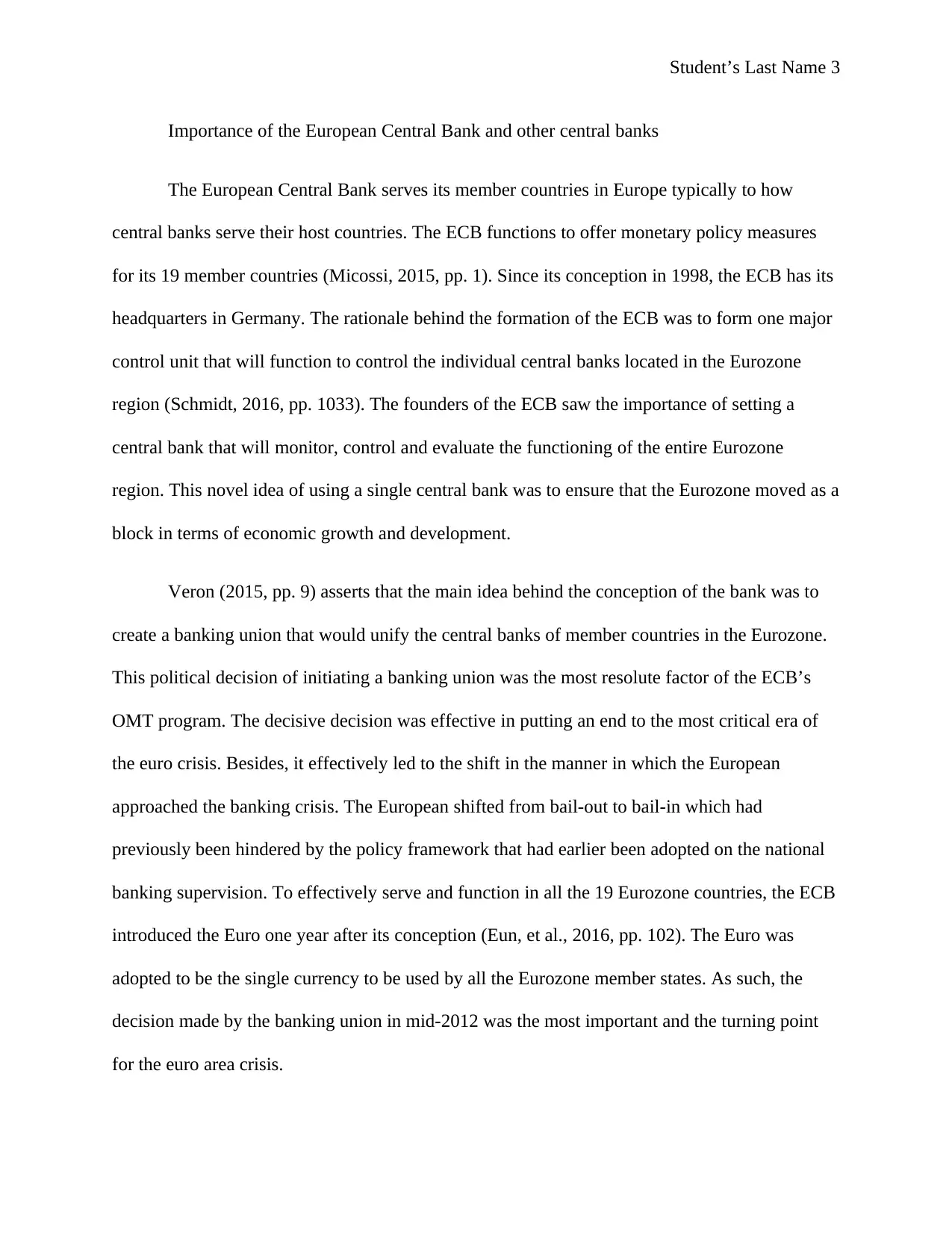
Student’s Last Name 3
Importance of the European Central Bank and other central banks
The European Central Bank serves its member countries in Europe typically to how
central banks serve their host countries. The ECB functions to offer monetary policy measures
for its 19 member countries (Micossi, 2015, pp. 1). Since its conception in 1998, the ECB has its
headquarters in Germany. The rationale behind the formation of the ECB was to form one major
control unit that will function to control the individual central banks located in the Eurozone
region (Schmidt, 2016, pp. 1033). The founders of the ECB saw the importance of setting a
central bank that will monitor, control and evaluate the functioning of the entire Eurozone
region. This novel idea of using a single central bank was to ensure that the Eurozone moved as a
block in terms of economic growth and development.
Veron (2015, pp. 9) asserts that the main idea behind the conception of the bank was to
create a banking union that would unify the central banks of member countries in the Eurozone.
This political decision of initiating a banking union was the most resolute factor of the ECB’s
OMT program. The decisive decision was effective in putting an end to the most critical era of
the euro crisis. Besides, it effectively led to the shift in the manner in which the European
approached the banking crisis. The European shifted from bail-out to bail-in which had
previously been hindered by the policy framework that had earlier been adopted on the national
banking supervision. To effectively serve and function in all the 19 Eurozone countries, the ECB
introduced the Euro one year after its conception (Eun, et al., 2016, pp. 102). The Euro was
adopted to be the single currency to be used by all the Eurozone member states. As such, the
decision made by the banking union in mid-2012 was the most important and the turning point
for the euro area crisis.
Importance of the European Central Bank and other central banks
The European Central Bank serves its member countries in Europe typically to how
central banks serve their host countries. The ECB functions to offer monetary policy measures
for its 19 member countries (Micossi, 2015, pp. 1). Since its conception in 1998, the ECB has its
headquarters in Germany. The rationale behind the formation of the ECB was to form one major
control unit that will function to control the individual central banks located in the Eurozone
region (Schmidt, 2016, pp. 1033). The founders of the ECB saw the importance of setting a
central bank that will monitor, control and evaluate the functioning of the entire Eurozone
region. This novel idea of using a single central bank was to ensure that the Eurozone moved as a
block in terms of economic growth and development.
Veron (2015, pp. 9) asserts that the main idea behind the conception of the bank was to
create a banking union that would unify the central banks of member countries in the Eurozone.
This political decision of initiating a banking union was the most resolute factor of the ECB’s
OMT program. The decisive decision was effective in putting an end to the most critical era of
the euro crisis. Besides, it effectively led to the shift in the manner in which the European
approached the banking crisis. The European shifted from bail-out to bail-in which had
previously been hindered by the policy framework that had earlier been adopted on the national
banking supervision. To effectively serve and function in all the 19 Eurozone countries, the ECB
introduced the Euro one year after its conception (Eun, et al., 2016, pp. 102). The Euro was
adopted to be the single currency to be used by all the Eurozone member states. As such, the
decision made by the banking union in mid-2012 was the most important and the turning point
for the euro area crisis.
⊘ This is a preview!⊘
Do you want full access?
Subscribe today to unlock all pages.

Trusted by 1+ million students worldwide
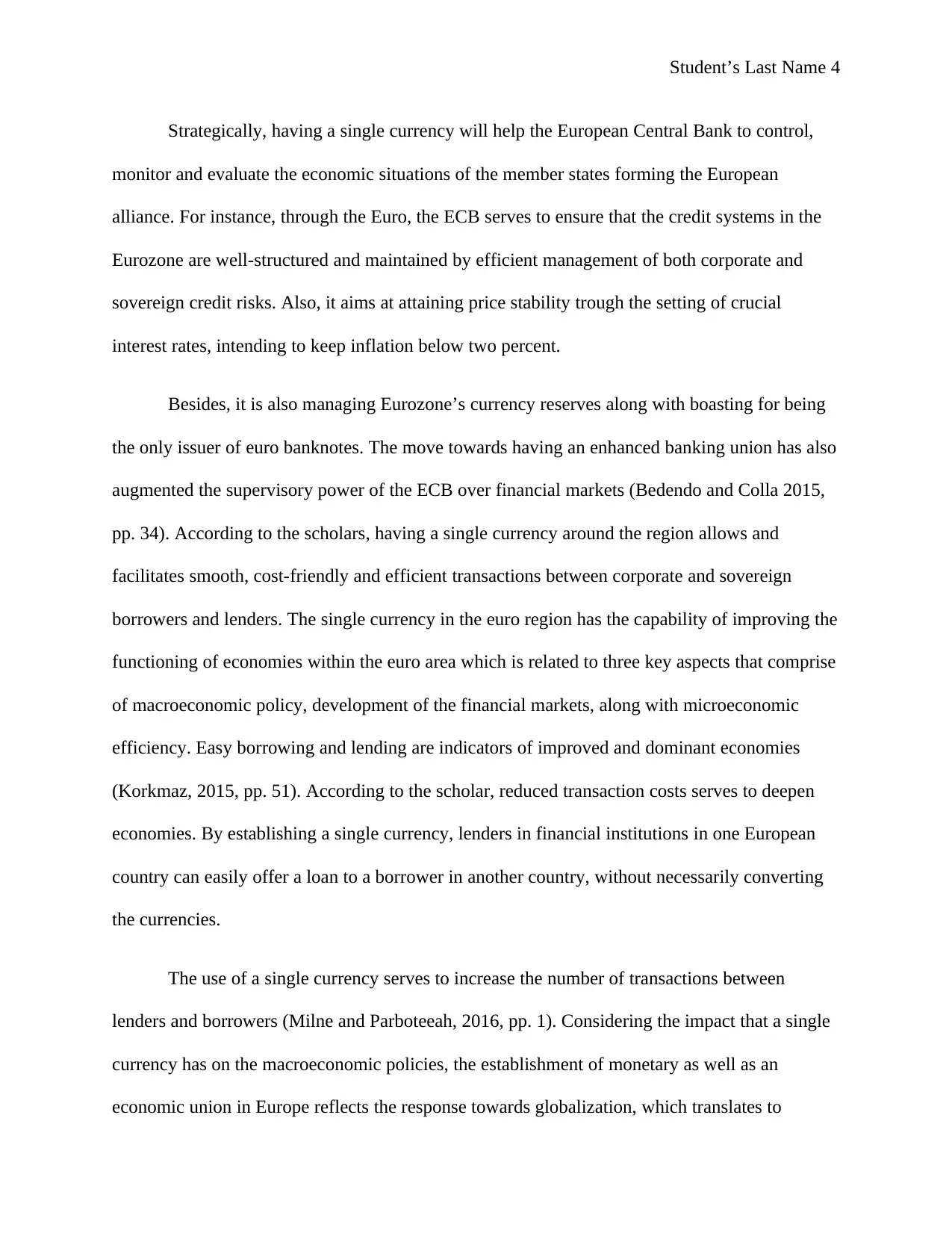
Student’s Last Name 4
Strategically, having a single currency will help the European Central Bank to control,
monitor and evaluate the economic situations of the member states forming the European
alliance. For instance, through the Euro, the ECB serves to ensure that the credit systems in the
Eurozone are well-structured and maintained by efficient management of both corporate and
sovereign credit risks. Also, it aims at attaining price stability trough the setting of crucial
interest rates, intending to keep inflation below two percent.
Besides, it is also managing Eurozone’s currency reserves along with boasting for being
the only issuer of euro banknotes. The move towards having an enhanced banking union has also
augmented the supervisory power of the ECB over financial markets (Bedendo and Colla 2015,
pp. 34). According to the scholars, having a single currency around the region allows and
facilitates smooth, cost-friendly and efficient transactions between corporate and sovereign
borrowers and lenders. The single currency in the euro region has the capability of improving the
functioning of economies within the euro area which is related to three key aspects that comprise
of macroeconomic policy, development of the financial markets, along with microeconomic
efficiency. Easy borrowing and lending are indicators of improved and dominant economies
(Korkmaz, 2015, pp. 51). According to the scholar, reduced transaction costs serves to deepen
economies. By establishing a single currency, lenders in financial institutions in one European
country can easily offer a loan to a borrower in another country, without necessarily converting
the currencies.
The use of a single currency serves to increase the number of transactions between
lenders and borrowers (Milne and Parboteeah, 2016, pp. 1). Considering the impact that a single
currency has on the macroeconomic policies, the establishment of monetary as well as an
economic union in Europe reflects the response towards globalization, which translates to
Strategically, having a single currency will help the European Central Bank to control,
monitor and evaluate the economic situations of the member states forming the European
alliance. For instance, through the Euro, the ECB serves to ensure that the credit systems in the
Eurozone are well-structured and maintained by efficient management of both corporate and
sovereign credit risks. Also, it aims at attaining price stability trough the setting of crucial
interest rates, intending to keep inflation below two percent.
Besides, it is also managing Eurozone’s currency reserves along with boasting for being
the only issuer of euro banknotes. The move towards having an enhanced banking union has also
augmented the supervisory power of the ECB over financial markets (Bedendo and Colla 2015,
pp. 34). According to the scholars, having a single currency around the region allows and
facilitates smooth, cost-friendly and efficient transactions between corporate and sovereign
borrowers and lenders. The single currency in the euro region has the capability of improving the
functioning of economies within the euro area which is related to three key aspects that comprise
of macroeconomic policy, development of the financial markets, along with microeconomic
efficiency. Easy borrowing and lending are indicators of improved and dominant economies
(Korkmaz, 2015, pp. 51). According to the scholar, reduced transaction costs serves to deepen
economies. By establishing a single currency, lenders in financial institutions in one European
country can easily offer a loan to a borrower in another country, without necessarily converting
the currencies.
The use of a single currency serves to increase the number of transactions between
lenders and borrowers (Milne and Parboteeah, 2016, pp. 1). Considering the impact that a single
currency has on the macroeconomic policies, the establishment of monetary as well as an
economic union in Europe reflects the response towards globalization, which translates to
Paraphrase This Document
Need a fresh take? Get an instant paraphrase of this document with our AI Paraphraser
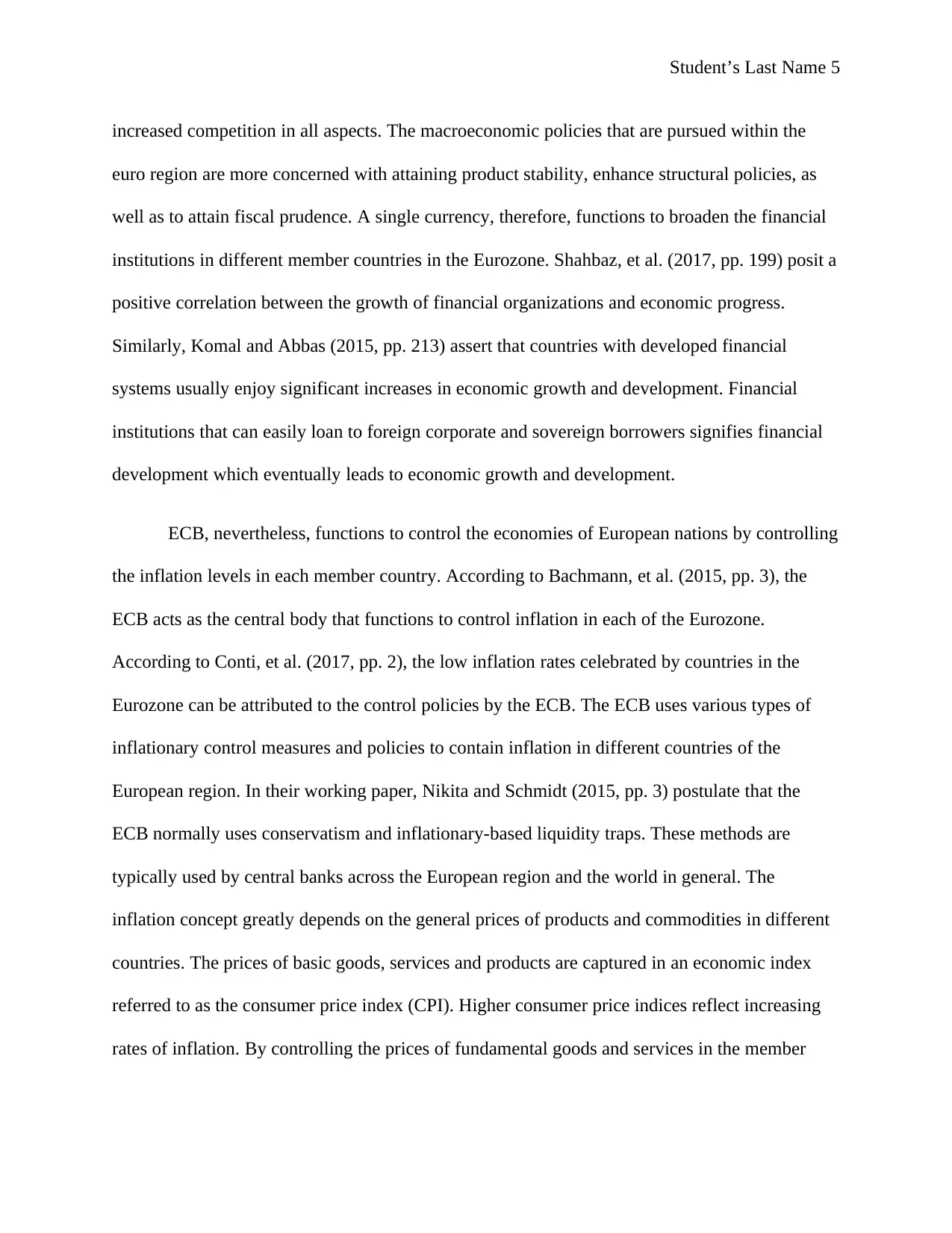
Student’s Last Name 5
increased competition in all aspects. The macroeconomic policies that are pursued within the
euro region are more concerned with attaining product stability, enhance structural policies, as
well as to attain fiscal prudence. A single currency, therefore, functions to broaden the financial
institutions in different member countries in the Eurozone. Shahbaz, et al. (2017, pp. 199) posit a
positive correlation between the growth of financial organizations and economic progress.
Similarly, Komal and Abbas (2015, pp. 213) assert that countries with developed financial
systems usually enjoy significant increases in economic growth and development. Financial
institutions that can easily loan to foreign corporate and sovereign borrowers signifies financial
development which eventually leads to economic growth and development.
ECB, nevertheless, functions to control the economies of European nations by controlling
the inflation levels in each member country. According to Bachmann, et al. (2015, pp. 3), the
ECB acts as the central body that functions to control inflation in each of the Eurozone.
According to Conti, et al. (2017, pp. 2), the low inflation rates celebrated by countries in the
Eurozone can be attributed to the control policies by the ECB. The ECB uses various types of
inflationary control measures and policies to contain inflation in different countries of the
European region. In their working paper, Nikita and Schmidt (2015, pp. 3) postulate that the
ECB normally uses conservatism and inflationary-based liquidity traps. These methods are
typically used by central banks across the European region and the world in general. The
inflation concept greatly depends on the general prices of products and commodities in different
countries. The prices of basic goods, services and products are captured in an economic index
referred to as the consumer price index (CPI). Higher consumer price indices reflect increasing
rates of inflation. By controlling the prices of fundamental goods and services in the member
increased competition in all aspects. The macroeconomic policies that are pursued within the
euro region are more concerned with attaining product stability, enhance structural policies, as
well as to attain fiscal prudence. A single currency, therefore, functions to broaden the financial
institutions in different member countries in the Eurozone. Shahbaz, et al. (2017, pp. 199) posit a
positive correlation between the growth of financial organizations and economic progress.
Similarly, Komal and Abbas (2015, pp. 213) assert that countries with developed financial
systems usually enjoy significant increases in economic growth and development. Financial
institutions that can easily loan to foreign corporate and sovereign borrowers signifies financial
development which eventually leads to economic growth and development.
ECB, nevertheless, functions to control the economies of European nations by controlling
the inflation levels in each member country. According to Bachmann, et al. (2015, pp. 3), the
ECB acts as the central body that functions to control inflation in each of the Eurozone.
According to Conti, et al. (2017, pp. 2), the low inflation rates celebrated by countries in the
Eurozone can be attributed to the control policies by the ECB. The ECB uses various types of
inflationary control measures and policies to contain inflation in different countries of the
European region. In their working paper, Nikita and Schmidt (2015, pp. 3) postulate that the
ECB normally uses conservatism and inflationary-based liquidity traps. These methods are
typically used by central banks across the European region and the world in general. The
inflation concept greatly depends on the general prices of products and commodities in different
countries. The prices of basic goods, services and products are captured in an economic index
referred to as the consumer price index (CPI). Higher consumer price indices reflect increasing
rates of inflation. By controlling the prices of fundamental goods and services in the member
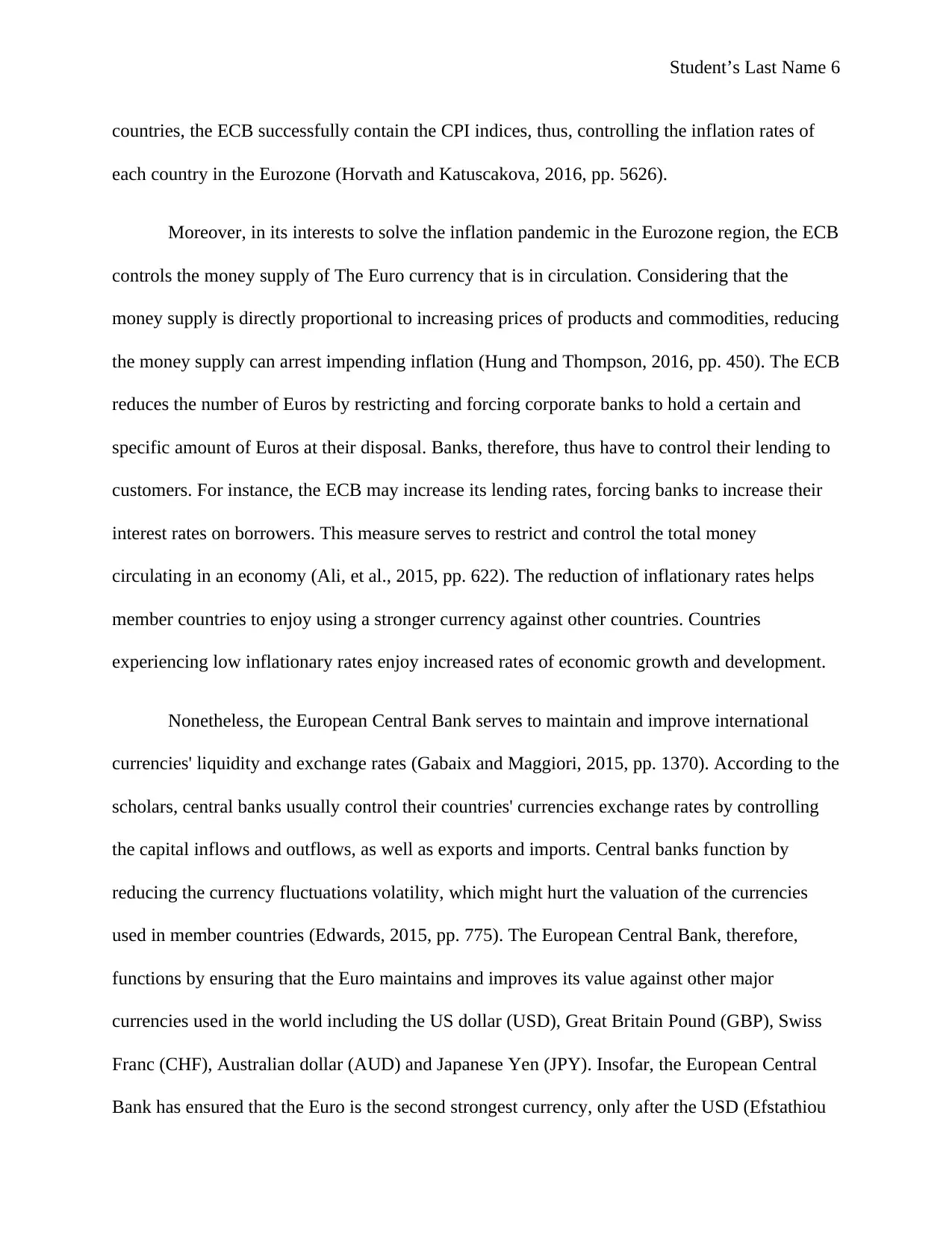
Student’s Last Name 6
countries, the ECB successfully contain the CPI indices, thus, controlling the inflation rates of
each country in the Eurozone (Horvath and Katuscakova, 2016, pp. 5626).
Moreover, in its interests to solve the inflation pandemic in the Eurozone region, the ECB
controls the money supply of The Euro currency that is in circulation. Considering that the
money supply is directly proportional to increasing prices of products and commodities, reducing
the money supply can arrest impending inflation (Hung and Thompson, 2016, pp. 450). The ECB
reduces the number of Euros by restricting and forcing corporate banks to hold a certain and
specific amount of Euros at their disposal. Banks, therefore, thus have to control their lending to
customers. For instance, the ECB may increase its lending rates, forcing banks to increase their
interest rates on borrowers. This measure serves to restrict and control the total money
circulating in an economy (Ali, et al., 2015, pp. 622). The reduction of inflationary rates helps
member countries to enjoy using a stronger currency against other countries. Countries
experiencing low inflationary rates enjoy increased rates of economic growth and development.
Nonetheless, the European Central Bank serves to maintain and improve international
currencies' liquidity and exchange rates (Gabaix and Maggiori, 2015, pp. 1370). According to the
scholars, central banks usually control their countries' currencies exchange rates by controlling
the capital inflows and outflows, as well as exports and imports. Central banks function by
reducing the currency fluctuations volatility, which might hurt the valuation of the currencies
used in member countries (Edwards, 2015, pp. 775). The European Central Bank, therefore,
functions by ensuring that the Euro maintains and improves its value against other major
currencies used in the world including the US dollar (USD), Great Britain Pound (GBP), Swiss
Franc (CHF), Australian dollar (AUD) and Japanese Yen (JPY). Insofar, the European Central
Bank has ensured that the Euro is the second strongest currency, only after the USD (Efstathiou
countries, the ECB successfully contain the CPI indices, thus, controlling the inflation rates of
each country in the Eurozone (Horvath and Katuscakova, 2016, pp. 5626).
Moreover, in its interests to solve the inflation pandemic in the Eurozone region, the ECB
controls the money supply of The Euro currency that is in circulation. Considering that the
money supply is directly proportional to increasing prices of products and commodities, reducing
the money supply can arrest impending inflation (Hung and Thompson, 2016, pp. 450). The ECB
reduces the number of Euros by restricting and forcing corporate banks to hold a certain and
specific amount of Euros at their disposal. Banks, therefore, thus have to control their lending to
customers. For instance, the ECB may increase its lending rates, forcing banks to increase their
interest rates on borrowers. This measure serves to restrict and control the total money
circulating in an economy (Ali, et al., 2015, pp. 622). The reduction of inflationary rates helps
member countries to enjoy using a stronger currency against other countries. Countries
experiencing low inflationary rates enjoy increased rates of economic growth and development.
Nonetheless, the European Central Bank serves to maintain and improve international
currencies' liquidity and exchange rates (Gabaix and Maggiori, 2015, pp. 1370). According to the
scholars, central banks usually control their countries' currencies exchange rates by controlling
the capital inflows and outflows, as well as exports and imports. Central banks function by
reducing the currency fluctuations volatility, which might hurt the valuation of the currencies
used in member countries (Edwards, 2015, pp. 775). The European Central Bank, therefore,
functions by ensuring that the Euro maintains and improves its value against other major
currencies used in the world including the US dollar (USD), Great Britain Pound (GBP), Swiss
Franc (CHF), Australian dollar (AUD) and Japanese Yen (JPY). Insofar, the European Central
Bank has ensured that the Euro is the second strongest currency, only after the USD (Efstathiou
⊘ This is a preview!⊘
Do you want full access?
Subscribe today to unlock all pages.

Trusted by 1+ million students worldwide
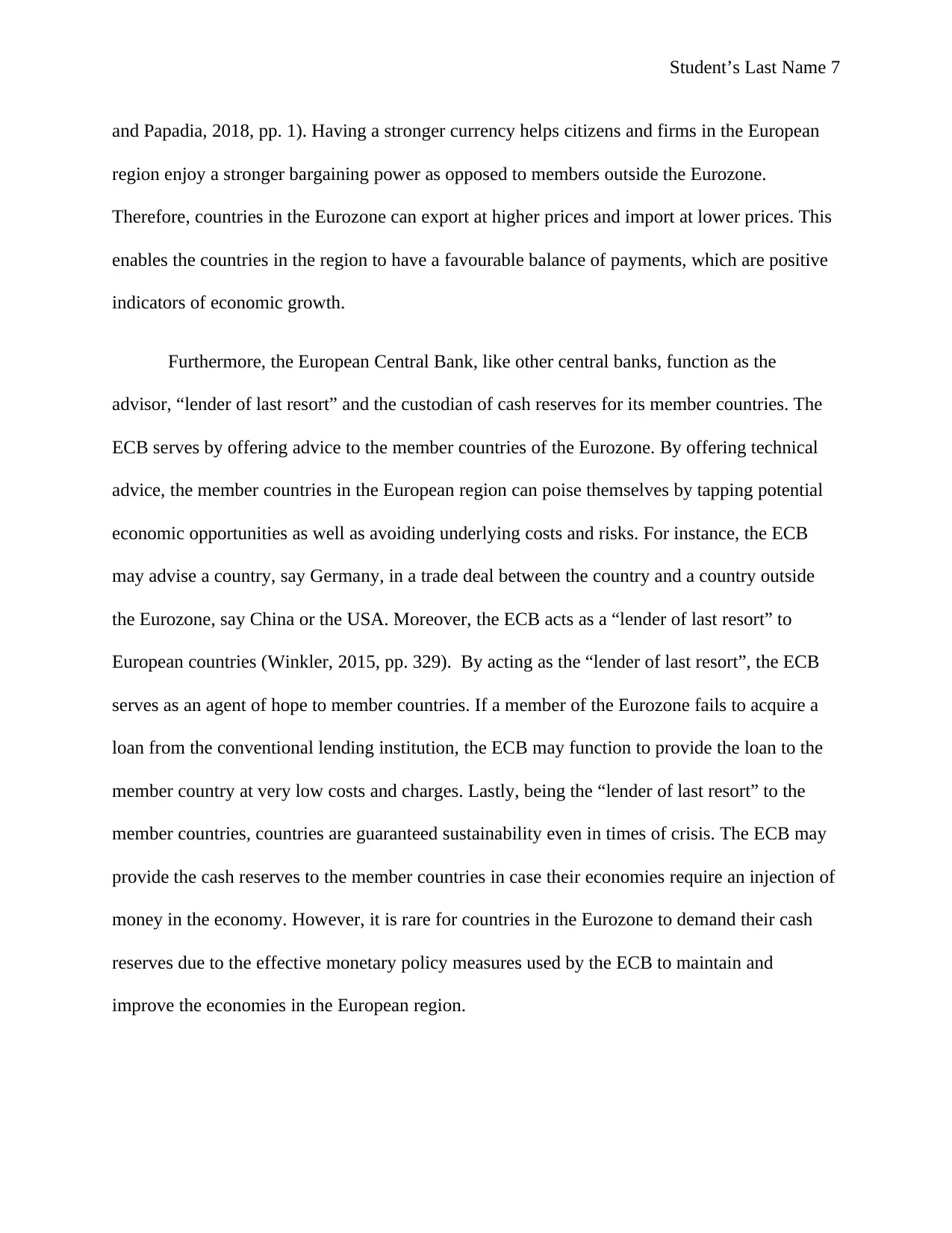
Student’s Last Name 7
and Papadia, 2018, pp. 1). Having a stronger currency helps citizens and firms in the European
region enjoy a stronger bargaining power as opposed to members outside the Eurozone.
Therefore, countries in the Eurozone can export at higher prices and import at lower prices. This
enables the countries in the region to have a favourable balance of payments, which are positive
indicators of economic growth.
Furthermore, the European Central Bank, like other central banks, function as the
advisor, “lender of last resort” and the custodian of cash reserves for its member countries. The
ECB serves by offering advice to the member countries of the Eurozone. By offering technical
advice, the member countries in the European region can poise themselves by tapping potential
economic opportunities as well as avoiding underlying costs and risks. For instance, the ECB
may advise a country, say Germany, in a trade deal between the country and a country outside
the Eurozone, say China or the USA. Moreover, the ECB acts as a “lender of last resort” to
European countries (Winkler, 2015, pp. 329). By acting as the “lender of last resort”, the ECB
serves as an agent of hope to member countries. If a member of the Eurozone fails to acquire a
loan from the conventional lending institution, the ECB may function to provide the loan to the
member country at very low costs and charges. Lastly, being the “lender of last resort” to the
member countries, countries are guaranteed sustainability even in times of crisis. The ECB may
provide the cash reserves to the member countries in case their economies require an injection of
money in the economy. However, it is rare for countries in the Eurozone to demand their cash
reserves due to the effective monetary policy measures used by the ECB to maintain and
improve the economies in the European region.
and Papadia, 2018, pp. 1). Having a stronger currency helps citizens and firms in the European
region enjoy a stronger bargaining power as opposed to members outside the Eurozone.
Therefore, countries in the Eurozone can export at higher prices and import at lower prices. This
enables the countries in the region to have a favourable balance of payments, which are positive
indicators of economic growth.
Furthermore, the European Central Bank, like other central banks, function as the
advisor, “lender of last resort” and the custodian of cash reserves for its member countries. The
ECB serves by offering advice to the member countries of the Eurozone. By offering technical
advice, the member countries in the European region can poise themselves by tapping potential
economic opportunities as well as avoiding underlying costs and risks. For instance, the ECB
may advise a country, say Germany, in a trade deal between the country and a country outside
the Eurozone, say China or the USA. Moreover, the ECB acts as a “lender of last resort” to
European countries (Winkler, 2015, pp. 329). By acting as the “lender of last resort”, the ECB
serves as an agent of hope to member countries. If a member of the Eurozone fails to acquire a
loan from the conventional lending institution, the ECB may function to provide the loan to the
member country at very low costs and charges. Lastly, being the “lender of last resort” to the
member countries, countries are guaranteed sustainability even in times of crisis. The ECB may
provide the cash reserves to the member countries in case their economies require an injection of
money in the economy. However, it is rare for countries in the Eurozone to demand their cash
reserves due to the effective monetary policy measures used by the ECB to maintain and
improve the economies in the European region.
Paraphrase This Document
Need a fresh take? Get an instant paraphrase of this document with our AI Paraphraser
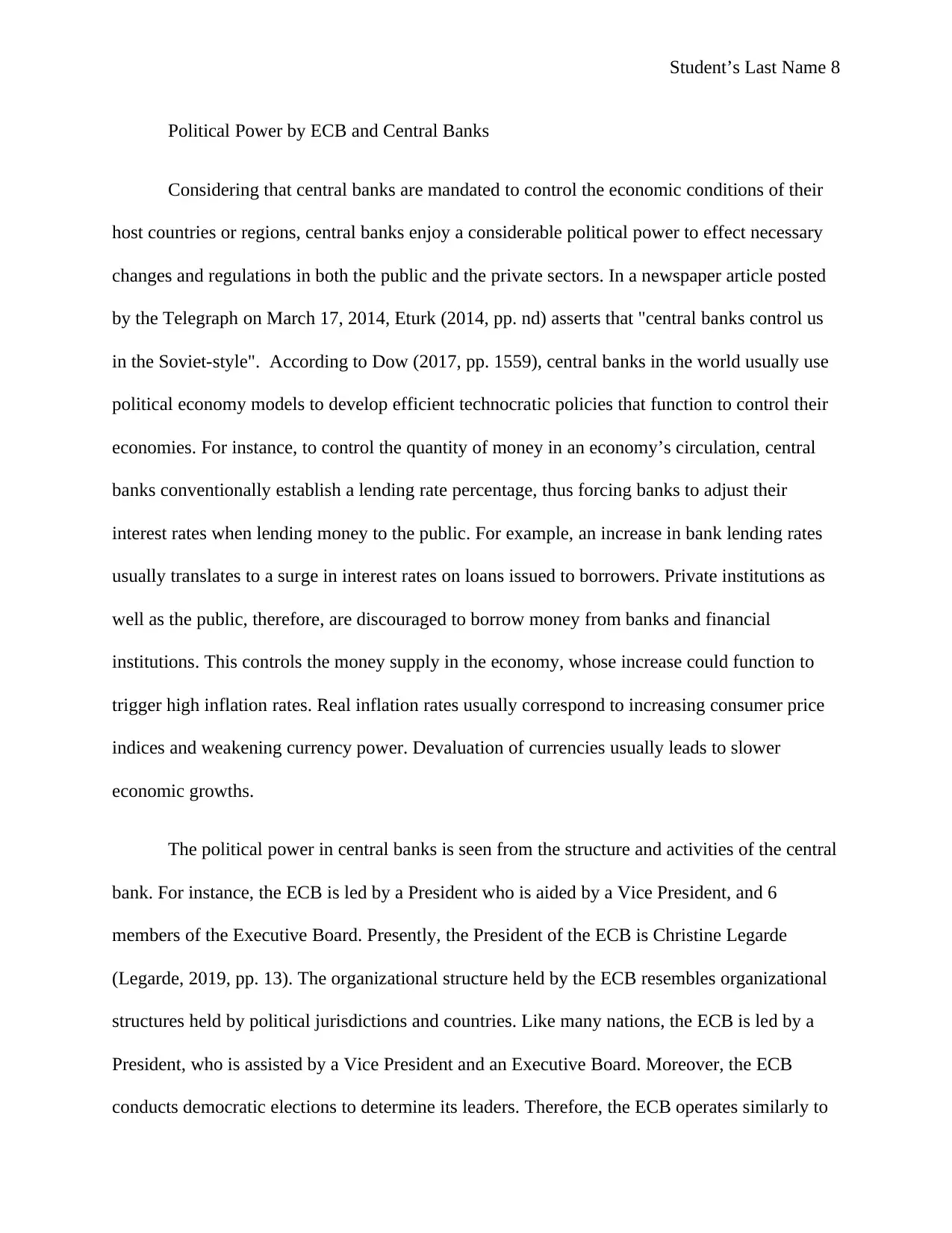
Student’s Last Name 8
Political Power by ECB and Central Banks
Considering that central banks are mandated to control the economic conditions of their
host countries or regions, central banks enjoy a considerable political power to effect necessary
changes and regulations in both the public and the private sectors. In a newspaper article posted
by the Telegraph on March 17, 2014, Eturk (2014, pp. nd) asserts that "central banks control us
in the Soviet-style". According to Dow (2017, pp. 1559), central banks in the world usually use
political economy models to develop efficient technocratic policies that function to control their
economies. For instance, to control the quantity of money in an economy’s circulation, central
banks conventionally establish a lending rate percentage, thus forcing banks to adjust their
interest rates when lending money to the public. For example, an increase in bank lending rates
usually translates to a surge in interest rates on loans issued to borrowers. Private institutions as
well as the public, therefore, are discouraged to borrow money from banks and financial
institutions. This controls the money supply in the economy, whose increase could function to
trigger high inflation rates. Real inflation rates usually correspond to increasing consumer price
indices and weakening currency power. Devaluation of currencies usually leads to slower
economic growths.
The political power in central banks is seen from the structure and activities of the central
bank. For instance, the ECB is led by a President who is aided by a Vice President, and 6
members of the Executive Board. Presently, the President of the ECB is Christine Legarde
(Legarde, 2019, pp. 13). The organizational structure held by the ECB resembles organizational
structures held by political jurisdictions and countries. Like many nations, the ECB is led by a
President, who is assisted by a Vice President and an Executive Board. Moreover, the ECB
conducts democratic elections to determine its leaders. Therefore, the ECB operates similarly to
Political Power by ECB and Central Banks
Considering that central banks are mandated to control the economic conditions of their
host countries or regions, central banks enjoy a considerable political power to effect necessary
changes and regulations in both the public and the private sectors. In a newspaper article posted
by the Telegraph on March 17, 2014, Eturk (2014, pp. nd) asserts that "central banks control us
in the Soviet-style". According to Dow (2017, pp. 1559), central banks in the world usually use
political economy models to develop efficient technocratic policies that function to control their
economies. For instance, to control the quantity of money in an economy’s circulation, central
banks conventionally establish a lending rate percentage, thus forcing banks to adjust their
interest rates when lending money to the public. For example, an increase in bank lending rates
usually translates to a surge in interest rates on loans issued to borrowers. Private institutions as
well as the public, therefore, are discouraged to borrow money from banks and financial
institutions. This controls the money supply in the economy, whose increase could function to
trigger high inflation rates. Real inflation rates usually correspond to increasing consumer price
indices and weakening currency power. Devaluation of currencies usually leads to slower
economic growths.
The political power in central banks is seen from the structure and activities of the central
bank. For instance, the ECB is led by a President who is aided by a Vice President, and 6
members of the Executive Board. Presently, the President of the ECB is Christine Legarde
(Legarde, 2019, pp. 13). The organizational structure held by the ECB resembles organizational
structures held by political jurisdictions and countries. Like many nations, the ECB is led by a
President, who is assisted by a Vice President and an Executive Board. Moreover, the ECB
conducts democratic elections to determine its leaders. Therefore, the ECB operates similarly to
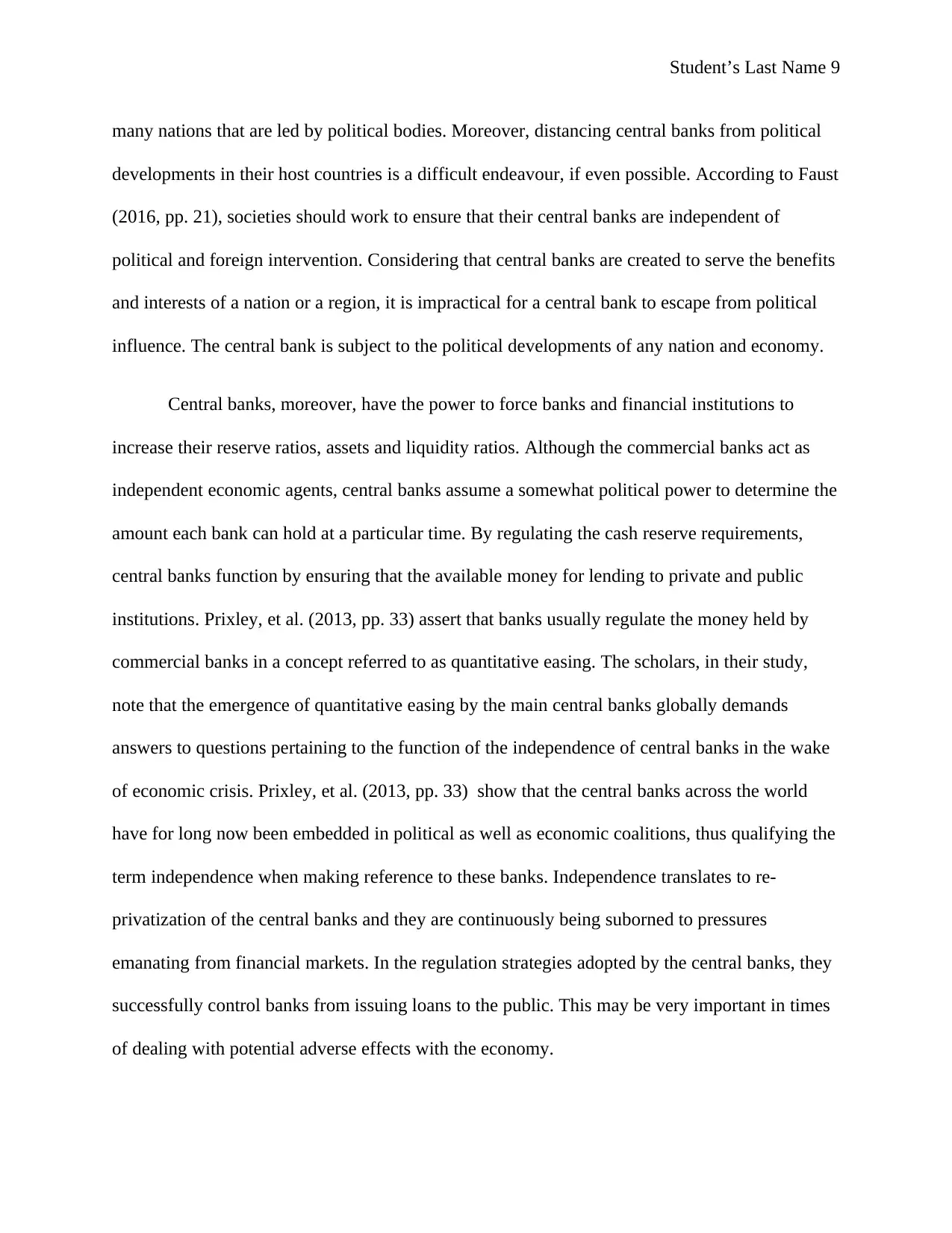
Student’s Last Name 9
many nations that are led by political bodies. Moreover, distancing central banks from political
developments in their host countries is a difficult endeavour, if even possible. According to Faust
(2016, pp. 21), societies should work to ensure that their central banks are independent of
political and foreign intervention. Considering that central banks are created to serve the benefits
and interests of a nation or a region, it is impractical for a central bank to escape from political
influence. The central bank is subject to the political developments of any nation and economy.
Central banks, moreover, have the power to force banks and financial institutions to
increase their reserve ratios, assets and liquidity ratios. Although the commercial banks act as
independent economic agents, central banks assume a somewhat political power to determine the
amount each bank can hold at a particular time. By regulating the cash reserve requirements,
central banks function by ensuring that the available money for lending to private and public
institutions. Prixley, et al. (2013, pp. 33) assert that banks usually regulate the money held by
commercial banks in a concept referred to as quantitative easing. The scholars, in their study,
note that the emergence of quantitative easing by the main central banks globally demands
answers to questions pertaining to the function of the independence of central banks in the wake
of economic crisis. Prixley, et al. (2013, pp. 33) show that the central banks across the world
have for long now been embedded in political as well as economic coalitions, thus qualifying the
term independence when making reference to these banks. Independence translates to re-
privatization of the central banks and they are continuously being suborned to pressures
emanating from financial markets. In the regulation strategies adopted by the central banks, they
successfully control banks from issuing loans to the public. This may be very important in times
of dealing with potential adverse effects with the economy.
many nations that are led by political bodies. Moreover, distancing central banks from political
developments in their host countries is a difficult endeavour, if even possible. According to Faust
(2016, pp. 21), societies should work to ensure that their central banks are independent of
political and foreign intervention. Considering that central banks are created to serve the benefits
and interests of a nation or a region, it is impractical for a central bank to escape from political
influence. The central bank is subject to the political developments of any nation and economy.
Central banks, moreover, have the power to force banks and financial institutions to
increase their reserve ratios, assets and liquidity ratios. Although the commercial banks act as
independent economic agents, central banks assume a somewhat political power to determine the
amount each bank can hold at a particular time. By regulating the cash reserve requirements,
central banks function by ensuring that the available money for lending to private and public
institutions. Prixley, et al. (2013, pp. 33) assert that banks usually regulate the money held by
commercial banks in a concept referred to as quantitative easing. The scholars, in their study,
note that the emergence of quantitative easing by the main central banks globally demands
answers to questions pertaining to the function of the independence of central banks in the wake
of economic crisis. Prixley, et al. (2013, pp. 33) show that the central banks across the world
have for long now been embedded in political as well as economic coalitions, thus qualifying the
term independence when making reference to these banks. Independence translates to re-
privatization of the central banks and they are continuously being suborned to pressures
emanating from financial markets. In the regulation strategies adopted by the central banks, they
successfully control banks from issuing loans to the public. This may be very important in times
of dealing with potential adverse effects with the economy.
⊘ This is a preview!⊘
Do you want full access?
Subscribe today to unlock all pages.

Trusted by 1+ million students worldwide
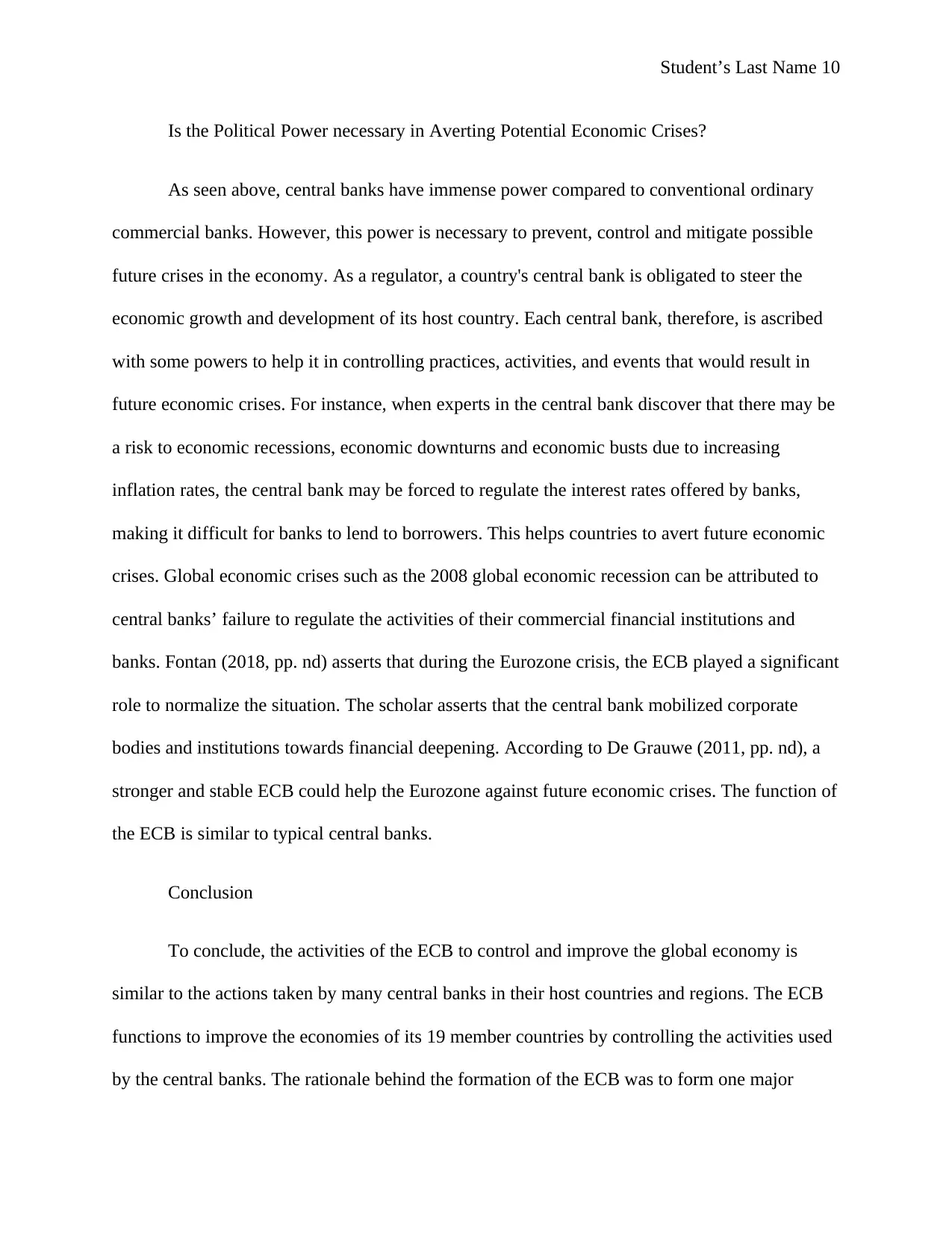
Student’s Last Name 10
Is the Political Power necessary in Averting Potential Economic Crises?
As seen above, central banks have immense power compared to conventional ordinary
commercial banks. However, this power is necessary to prevent, control and mitigate possible
future crises in the economy. As a regulator, a country's central bank is obligated to steer the
economic growth and development of its host country. Each central bank, therefore, is ascribed
with some powers to help it in controlling practices, activities, and events that would result in
future economic crises. For instance, when experts in the central bank discover that there may be
a risk to economic recessions, economic downturns and economic busts due to increasing
inflation rates, the central bank may be forced to regulate the interest rates offered by banks,
making it difficult for banks to lend to borrowers. This helps countries to avert future economic
crises. Global economic crises such as the 2008 global economic recession can be attributed to
central banks’ failure to regulate the activities of their commercial financial institutions and
banks. Fontan (2018, pp. nd) asserts that during the Eurozone crisis, the ECB played a significant
role to normalize the situation. The scholar asserts that the central bank mobilized corporate
bodies and institutions towards financial deepening. According to De Grauwe (2011, pp. nd), a
stronger and stable ECB could help the Eurozone against future economic crises. The function of
the ECB is similar to typical central banks.
Conclusion
To conclude, the activities of the ECB to control and improve the global economy is
similar to the actions taken by many central banks in their host countries and regions. The ECB
functions to improve the economies of its 19 member countries by controlling the activities used
by the central banks. The rationale behind the formation of the ECB was to form one major
Is the Political Power necessary in Averting Potential Economic Crises?
As seen above, central banks have immense power compared to conventional ordinary
commercial banks. However, this power is necessary to prevent, control and mitigate possible
future crises in the economy. As a regulator, a country's central bank is obligated to steer the
economic growth and development of its host country. Each central bank, therefore, is ascribed
with some powers to help it in controlling practices, activities, and events that would result in
future economic crises. For instance, when experts in the central bank discover that there may be
a risk to economic recessions, economic downturns and economic busts due to increasing
inflation rates, the central bank may be forced to regulate the interest rates offered by banks,
making it difficult for banks to lend to borrowers. This helps countries to avert future economic
crises. Global economic crises such as the 2008 global economic recession can be attributed to
central banks’ failure to regulate the activities of their commercial financial institutions and
banks. Fontan (2018, pp. nd) asserts that during the Eurozone crisis, the ECB played a significant
role to normalize the situation. The scholar asserts that the central bank mobilized corporate
bodies and institutions towards financial deepening. According to De Grauwe (2011, pp. nd), a
stronger and stable ECB could help the Eurozone against future economic crises. The function of
the ECB is similar to typical central banks.
Conclusion
To conclude, the activities of the ECB to control and improve the global economy is
similar to the actions taken by many central banks in their host countries and regions. The ECB
functions to improve the economies of its 19 member countries by controlling the activities used
by the central banks. The rationale behind the formation of the ECB was to form one major
Paraphrase This Document
Need a fresh take? Get an instant paraphrase of this document with our AI Paraphraser
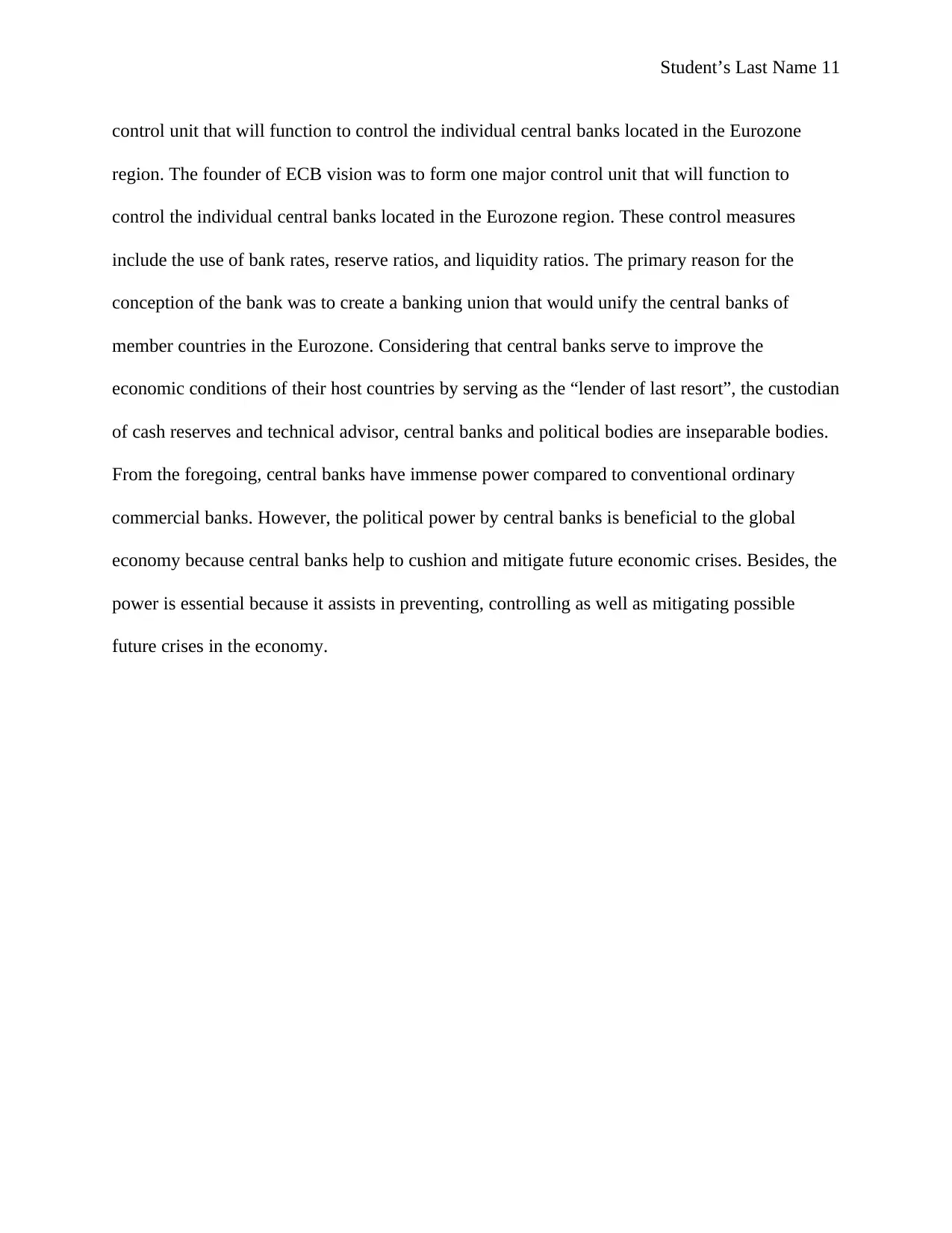
Student’s Last Name 11
control unit that will function to control the individual central banks located in the Eurozone
region. The founder of ECB vision was to form one major control unit that will function to
control the individual central banks located in the Eurozone region. These control measures
include the use of bank rates, reserve ratios, and liquidity ratios. The primary reason for the
conception of the bank was to create a banking union that would unify the central banks of
member countries in the Eurozone. Considering that central banks serve to improve the
economic conditions of their host countries by serving as the “lender of last resort”, the custodian
of cash reserves and technical advisor, central banks and political bodies are inseparable bodies.
From the foregoing, central banks have immense power compared to conventional ordinary
commercial banks. However, the political power by central banks is beneficial to the global
economy because central banks help to cushion and mitigate future economic crises. Besides, the
power is essential because it assists in preventing, controlling as well as mitigating possible
future crises in the economy.
control unit that will function to control the individual central banks located in the Eurozone
region. The founder of ECB vision was to form one major control unit that will function to
control the individual central banks located in the Eurozone region. These control measures
include the use of bank rates, reserve ratios, and liquidity ratios. The primary reason for the
conception of the bank was to create a banking union that would unify the central banks of
member countries in the Eurozone. Considering that central banks serve to improve the
economic conditions of their host countries by serving as the “lender of last resort”, the custodian
of cash reserves and technical advisor, central banks and political bodies are inseparable bodies.
From the foregoing, central banks have immense power compared to conventional ordinary
commercial banks. However, the political power by central banks is beneficial to the global
economy because central banks help to cushion and mitigate future economic crises. Besides, the
power is essential because it assists in preventing, controlling as well as mitigating possible
future crises in the economy.
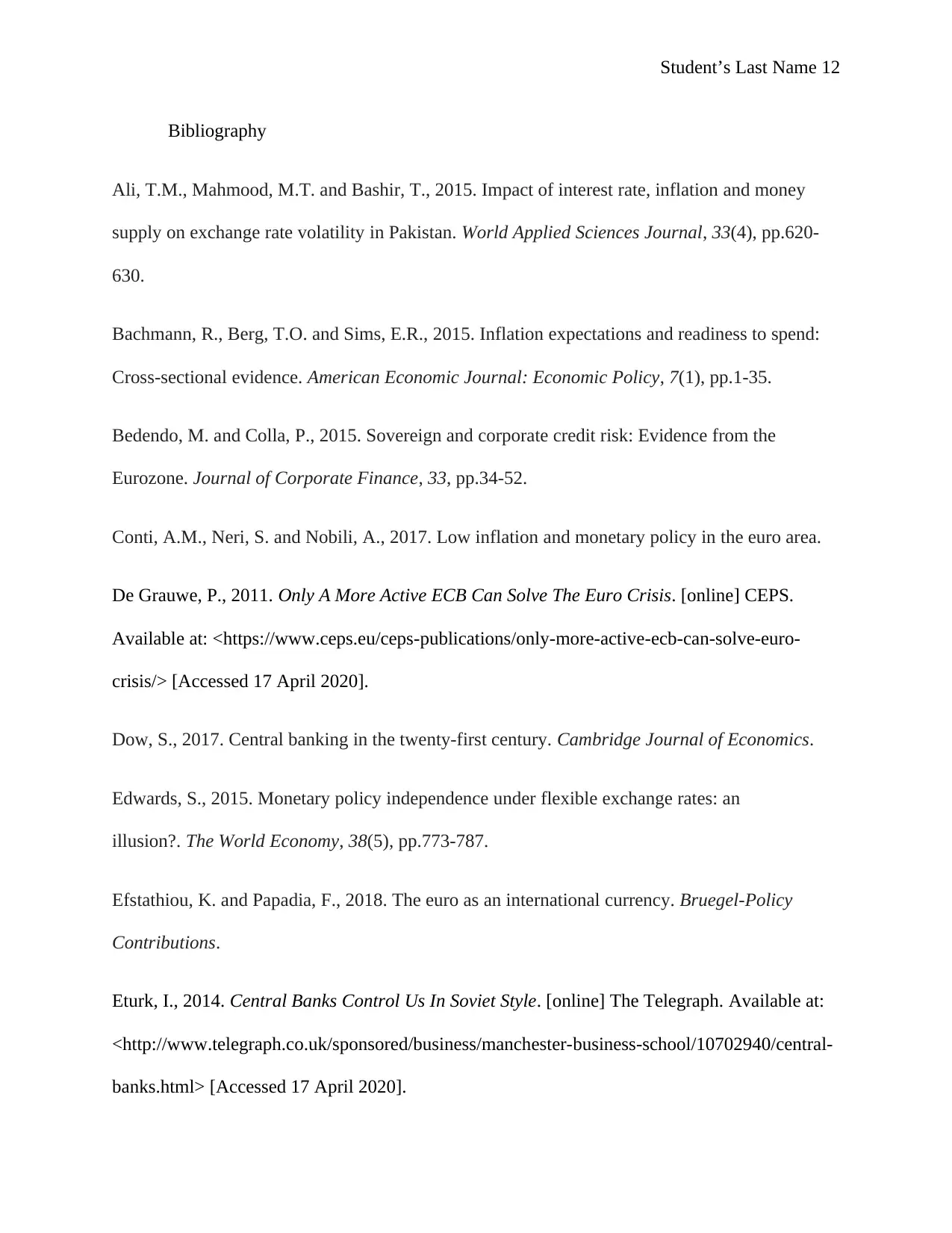
Student’s Last Name 12
Bibliography
Ali, T.M., Mahmood, M.T. and Bashir, T., 2015. Impact of interest rate, inflation and money
supply on exchange rate volatility in Pakistan. World Applied Sciences Journal, 33(4), pp.620-
630.
Bachmann, R., Berg, T.O. and Sims, E.R., 2015. Inflation expectations and readiness to spend:
Cross-sectional evidence. American Economic Journal: Economic Policy, 7(1), pp.1-35.
Bedendo, M. and Colla, P., 2015. Sovereign and corporate credit risk: Evidence from the
Eurozone. Journal of Corporate Finance, 33, pp.34-52.
Conti, A.M., Neri, S. and Nobili, A., 2017. Low inflation and monetary policy in the euro area.
De Grauwe, P., 2011. Only A More Active ECB Can Solve The Euro Crisis. [online] CEPS.
Available at: <https://www.ceps.eu/ceps-publications/only-more-active-ecb-can-solve-euro-
crisis/> [Accessed 17 April 2020].
Dow, S., 2017. Central banking in the twenty-first century. Cambridge Journal of Economics.
Edwards, S., 2015. Monetary policy independence under flexible exchange rates: an
illusion?. The World Economy, 38(5), pp.773-787.
Efstathiou, K. and Papadia, F., 2018. The euro as an international currency. Bruegel-Policy
Contributions.
Eturk, I., 2014. Central Banks Control Us In Soviet Style. [online] The Telegraph. Available at:
<http://www.telegraph.co.uk/sponsored/business/manchester-business-school/10702940/central-
banks.html> [Accessed 17 April 2020].
Bibliography
Ali, T.M., Mahmood, M.T. and Bashir, T., 2015. Impact of interest rate, inflation and money
supply on exchange rate volatility in Pakistan. World Applied Sciences Journal, 33(4), pp.620-
630.
Bachmann, R., Berg, T.O. and Sims, E.R., 2015. Inflation expectations and readiness to spend:
Cross-sectional evidence. American Economic Journal: Economic Policy, 7(1), pp.1-35.
Bedendo, M. and Colla, P., 2015. Sovereign and corporate credit risk: Evidence from the
Eurozone. Journal of Corporate Finance, 33, pp.34-52.
Conti, A.M., Neri, S. and Nobili, A., 2017. Low inflation and monetary policy in the euro area.
De Grauwe, P., 2011. Only A More Active ECB Can Solve The Euro Crisis. [online] CEPS.
Available at: <https://www.ceps.eu/ceps-publications/only-more-active-ecb-can-solve-euro-
crisis/> [Accessed 17 April 2020].
Dow, S., 2017. Central banking in the twenty-first century. Cambridge Journal of Economics.
Edwards, S., 2015. Monetary policy independence under flexible exchange rates: an
illusion?. The World Economy, 38(5), pp.773-787.
Efstathiou, K. and Papadia, F., 2018. The euro as an international currency. Bruegel-Policy
Contributions.
Eturk, I., 2014. Central Banks Control Us In Soviet Style. [online] The Telegraph. Available at:
<http://www.telegraph.co.uk/sponsored/business/manchester-business-school/10702940/central-
banks.html> [Accessed 17 April 2020].
⊘ This is a preview!⊘
Do you want full access?
Subscribe today to unlock all pages.

Trusted by 1+ million students worldwide
1 out of 14
Related Documents
Your All-in-One AI-Powered Toolkit for Academic Success.
+13062052269
info@desklib.com
Available 24*7 on WhatsApp / Email
![[object Object]](/_next/static/media/star-bottom.7253800d.svg)
Unlock your academic potential
Copyright © 2020–2025 A2Z Services. All Rights Reserved. Developed and managed by ZUCOL.





